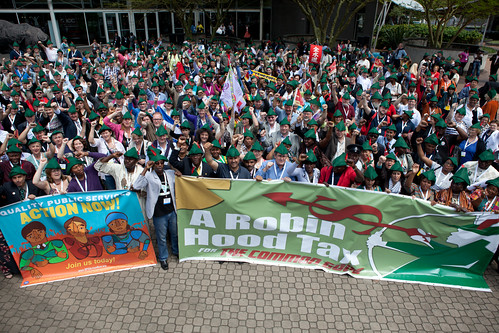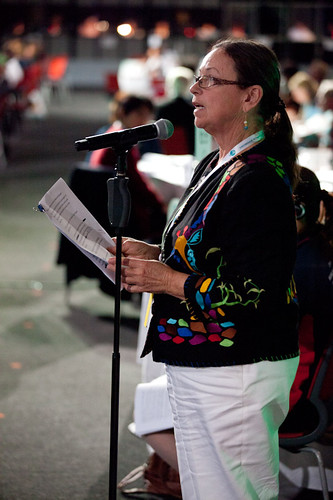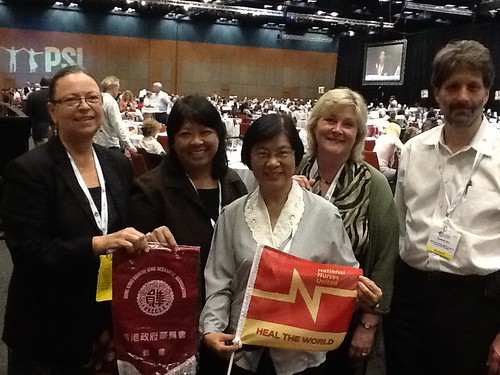Nurses Top Poll for Honesty, Ethical Standards for 11th Straight Year
It’s become an annual tradition. Nurses are the most trusted profession in the U.S….
RNs to Hold Candlelight Vigils in 20+ U.S. Cities December 10
RNs to Hold Candlelight Vigils in 20+ U.S. Cities (including Boston) Dec. 10
Call on Congress, White House – No Fiscal Cliff Cuts in Vital Programs
Nu…
Candlelight Vigil for Safe Patient Care: December 10
Who: Holy Family Hospital RNs and Supporters
When: Monday, December 10, 2012
Where: Across the street from the entrance of the hospital (70 E…
Don’t Push Seniors Off the ‘Fiscal Cliff’
December 3, 2012 by Chuck Idelson
With the November election rapidly fading into memory and the basic building blocks of a civil society once again under grave threat from Wall Street and their acolytes in Washington, nurses and other activists have, once again, had to step up the fight to protect basic programs and make the case for real revenue needed to build a sustainable future.
As December opened, National Nurses United unveiled a stark image of seniors precariously perched on the edge of the “fiscal cliff” and facing a questionable future as the White House and leaders in Congress debated their future.
“Don’t Push Seniors Off the ‘Fiscal Cliff.’ Tax Wall Street” is the message. NNU placed the image on more than 100 buses crisscrossing Washington, as well as on billboards in several cities across the U.S., part of a growing campaign by nurses and others insisting that Washington not throw seniors or American families in general under the “fiscal cliff” bus.
Concurrently, NNU is planning candlelight vigils outside some 20 Congressional offices, from Florida to California, on December 10, at some of them joining with members of a number of unions who are also pressing for a firm hand in Washington.
It won’t be the first time nurses have been in the streets since the election calling on Congress and the President to reject more punishing cuts demanded by those Nobel economist Paul Krugman calls “the deficit scolds,” and support for a meaningful tax on Wall Street speculation, the Robin Hood tax.
On November 14, nurses, HIV/AIDS activists, and other Robin Hood campaigners went to several Congressional offices with a similar message.
“This country has vast wealth but poor priorities,” said NNU Co-President Jean Ross, RN. “Social Security, Medicare, Medicaid, and the food stamp program are the economic bedrock of vast numbers of American families. To reduce these in any way is to do serious harm and lead to more poverty. We as nurses shudder at the thought of more harm to Americans. Don’t do it.”
There’s ample reason for concern. Despite pledges from the President, in meetings with labor and liberal policy groups since the election, and some tough language from a number of Democratic leaders, we’ve seen this movie before.
Nurses and other activists well remember the concessions made by President Obama and other Democratic leaders during first term debt ceiling discussions, and the President’s own statement during the first debate this fall that he and Republican candidate Mitt Romney, then titular leader of the “deficit scold” camp, had no real differences on Social Security. It was a statement that caused lots of angst on the left, and prompted a hurried response from the campaign that “President Obama will never privatize Social Security or undermine retirement security for middle-class Americans.”
But the mixed signals from Washington in late November remained worrisome. Illinois Sen. Dick Durbin, probably as close to Obama as anyone in the Senate, has dropped broad hints that the White House and top Democrats will agree to at least $400 billion in “entitlement” cuts and probably far more as the carrot to get votes for tax increases for the wealthiest Americans. That’s the price demanded by intransigent Republicans, whose hard line, some seem to have trouble remembering, was fully repudiated by voters on November 6.
What will the cuts be? Presumably some combination, speculated Politico, of “means-testing, raising the retirement age and other ‘efficiencies’ to be named later.”
Those cuts are exactly what nurses and other activists hope to head off. Why? Four years after Wall Street and the banksters crashed the U.S. and global economies, far too many families are still hurting. The priority in Washington should be economic recovery and revitalization, “building a sustainable full employment economy,” as PERI co-director Robert Pollin as aptly written, not further cuts in critical programs.
Whether emerging under the guise of the Simpson-Bowles recommendations, or negotiations over the debt ceiling, “fiscal cliff,” or a “grand bargain,” nurses and other activists know too many of the proposed solutions would just cause far greater suffering in Main Street communities while once again rewarding the Wall Street gamblers and titans who are the ultimate recipients of any money thrown at the debt. Krugman put it well when he wrote: “The deficit-scold movement was never really about the deficit. Instead, it was about using deficit fears to shred the social safety net.”
There are allies in Congress, of course, who can be counted on to oppose this sham, such as Rep. Keith Ellison who in response to the reported deal said:
“Progressives will not support any deal that cuts benefits for families and seniors who rely on Medicare, Medicaid and Social Security to put food on the table or cover their health costs. Last year, over 80 members of the Progressive, Black, and Asian Pacific-Islander Caucuses stood united in opposing an agreement that cut benefits for these families, and 44 members have introduced a resolution demanding these cuts be off the table.”
Instead of further bailouts for Wall Street, nurses say, it’s time to hold banks and investment firms accountable to revitalize the economies they did so much to damage. The best response is with a robust Robin Hood tax, HR 6411, the Inclusive Prosperity Act, introduced by Ellison for the Robin Hood campaign, which sets a small sales tax on the trading of stocks, bonds, derivatives, currencies, and other financial instruments, with a big bang for the economy, up to $350 billion every year for jobs, healthcare, and other vital needs.
That’s the message nurses are bringing to Washington, with the protests, and the latest ad campaign.
Ralph Nader on a simple way to avoid the fiscal cliff: Tax stock trades
By Ralph Nader, Published: November 30
In the debate over the “fiscal cliff,” President Obama and congressional Republicans have returned to the proposals that they were sparring over before the election. They remain at odds over key elements of revenue and spending. Yet both sides are unwilling to consider a minuscule tax on financial transactions that could be a major source of income.
A financial transaction tax would apply to purchases and sales of derivatives, options and stocks. The tax would be small, half a penny or less on each dollar of the transaction value, depending on the product. This idea is often called a “speculation tax,” because it would hit hardest at frothy high-volume trading as opposed to sober long-term investment.
Wall Street might object, but taxing its sales is hardly a radical idea. Americans in all but five states pay state sales taxes, ranging as high as 7 percent, every time they buy a car, an appliance, a pair of pants or piece of furniture, but a trader on Wall Street can buy and sell millions of dollars’ worth of financial products each day without paying a cent in sales taxes. A teacher or police officer who buys a $100 pair of shoes in the District or Maryland pays $6 in sales taxes. Meanwhile, if a financial speculation tax were applied to stock trades at a rate of 0.25 percent, a day trader would pay just 25 cents on every $100 worth of stock bought.
A speculation tax isn’t a new idea, either. Congress enacted one in 1914, and it remained in effect until 1966; initially it imposed a tax of 2 cents on every $100 sale or transfer of stock. The late Nobel Prize-winning economist James Tobin proposed a version to curb foreign exchange speculation in the 1970s. And I wrote about it a year ago, urging Congress to use it to show that it wasn’t deaf to the sentiments of the Occupy Wall Street movement.
It is an idea whose time has come once again.
At the heart of the debate over the fiscal cliff is the need to shrink our nation’s deficit while safeguarding a lackluster economic recovery by limiting the financial impact on average Americans. A speculation tax could do just that by raising revenue while having little effect on most Americans’ pocketbooks and reducing the devastation of runaway speculative trading on Wall Street.
According to a joint report from the Center for Economic and Policy Research and the Political Economy Research Institute, a speculation tax could raise as much as $350 billionannually. Even if we make the unrealistic assumption that such a tax would reduce trading volume on the stock market by half, it could still boost federal revenue by $175 billion a year.
Compare that with the policies being discussed in the fiscal cliff debate. Extending the George W. Bush-era tax cuts for all but the top 2 percent — as Obama has suggested — would cost $171 billion a year in lost revenue. Patching the alternative minimum tax to ensure that millions more Americans are not affected by it would cost $40 billion. Continuing to pay emergency federal unemployment benefits would cost $26 billion. A speculation tax could pay for each and every one of these — and then some.
As if its deficit-reducing potential weren’t enough, a financial transaction tax could reduce risky speculative trading that diverts resources from productive economic activity and can be very destabilizing, as the 2008-2009 crash demonstrated. In fact, this summer, more than 50 financial industry professionals, including past and present executives from Goldman Sachs, JPMorgan Chaseand Morgan Stanley, signed a letter to the Group of 20 and European leaders supporting a speculation tax. They pointed out that financial market activity has skyrocketed in the past few decades: The value of transactions is now 70 times greater than the size of the real global economy. Trading volume has grown exponentially, skyrocketing from 188 billion shares of stock traded on the Nasdaq and the New York Stock Exchange in 1995 to nearly 1 trillion in 2011. Each year, the notional value of over-the-counter derivatives traded worldwide totals trillions more.
In their letter, these professionals cautioned that although the main purpose of financial markets is to raise investment capital, allocate resources efficiently and mitigate risk, today’s markets, full of computer-driven, high-frequency trading, often undermine those goals. The Capital Institute’s John Fullerton, a former managing director at JPMorgan, has estimated that nearly 70 percent of equity-trading volume is composed of these types of speculative strategies.
Critics claim that a speculation tax would harm ordinary investors. But here is a reality check: Many of the automatic spending cuts and tax increases on middle-class Americans that are at stake in the fiscal cliff debate would be many times more painful for these investors. And the harmful aspects of a speculation tax can be addressed. Rep. Keith Ellison (D-Minn.), Rep. Peter DeFazio (D-Ore.) and Sen. Tom Harkin (D-Iowa) have proposed a financial transaction tax with mechanisms to protect most ordinary investors, either by exempting individuals with incomes below $50,000 or by providing a credit for the first $100,000 of stock transactions each year.
Other critics worry that a speculation tax would drive trading and wealth to offshore tax havens. However, this argument ignores the fact that Britain already subjects stock trades to a financial transaction tax, which generates billions every year. Forty countries had such a tax in place in 2011. Germany and France have voiced support for implementing one across the European Union.
It is now more than four years since the beginning of the financial crisis, and Americans are still feeling the pain. Unemployment is just below 8 percent, and underemployment hovers around 15 percent.
Meanwhile, the Obama administration has failed to hold the Wall Street banks that got us into this mess accountable. Instead, institutions such as Goldman Sachs, JPMorgan and Morgan Stanley — whose speculative trading arms helped fuel the crisis — all received huge bailouts from Treasury and massive interest-free loans from the Federal Reserve. These banks have a bigger market share than ever. Derivatives remain largely unregulated. And too many firms are still gambling with other people’s money.
But the financial transaction tax isn’t a cudgel for retribution against these institutions. It’s a practical tool to avert the financial woes that economists are predicting if we slide over the fiscal cliff. This tiny tax can produce modest salutary effects on behavior while generating much-needed revenue.
The president and congressional leaders need to find something that hasn’t been present in Washington for quite some time: the courage to place the interests of American workers ahead of the influence of Wall Street.
What’s more, we can use the money. Now is the time to enact — or, more accurately, reenact — a financial transaction tax.
###
Ralph Nader is a consumer advocate. His new book, “The Seventeen Solutions,” lays out his prescriptions for curing America’s social and economic ills.
Read more from Outlook, friend us on Facebook, and follow us on Twitter.
© The Washington Post Company
Nurses bring U.S. support for Robin Hood tax to global union movement
The worldwide campaign to enact Robin Hood taxes on financial speculation received a real boost in a major meeting of global union activists this week — with the help of U.S. nurses whose Robin Hood hats and messaging is becoming a familiar site at home.
Delegates representing 329 unions from 123 countries rallied today in the streets of Durban, South Africa for the Robin Hood Tax while also speaking out against austerity measures pushed by the same finance sectors that are the target of the tax.

NNU Co-Presidents Jean Ross, RN, and Deborah Burger, RN at a massive rally today in Durban, South Africa

The union leaders, representing 20 million workers, were in Durban attending the 29th World Congress of the Public Services International (PSI).
On Wednesday, PSI delegates heartily endorsed an NNU-sponsored resolution backing the Robin Hood tax — which sets a small fee on the trading of stocks, bonds, derivatives, currencies, and other financial instruments. Some 30 nations around the world already have a version of the tax, also known as a Financial Transaction Tax.

NNU Co-President Jean Ross, RN at the PSI Convention in South Africa
“The Robin Hood Tax Campaign is vital because we need a movement dedicated to standing up for our communities– for jobs, for health care, for decent housing, education, a secure retirement and quality public services that all of us so desperately need,” Jean Ross, RN, co-president of National Nurses United, told the congress.
The resolution, entitled, “The Global Fight-Back Against Austerity,” said, “The Robin Hood Tax has the opportunity to turn the tide in a century whose first decade has witnessed an appalling assault on equality and community. The time for the financial sector to pay a fair sales tax on its trading is long past due.”

NNU Co-President Deborah Burger, RN, addressing the congress
Speaking of the social and economic devastation caused by the world economic crisis worldwide, Deborah Burger, RN, NNU co-president, told the delegates:
“Working people did not cause this crisis, the bankers and the traders of the world’s financial markets did. Most of them have recouped their losses but the rest of us have paid the bill.
“It’s well known that it’s the poor and working class which are suffering – and deprivation has only intensified. This is a disgrace that requires not only our condemnation but our determined, united and collective action. The Robin Hood Tax Campaign is an essential part of that fight-back.”
The Robin Hood tax is, of course, making rapid advances around the world. France earlier this year implemented the tax and even banking industry-inspired critics of it admit it has proceded without the predicted fears.
Momentum continues to grow throughout Europe as well, as this report notes:
“Now Germany, Spain, Italy, Austria, Belgium, Portugal, Greece, Slovenia, Slovakia and Estonia have followed suit. Robin Hood Tax campaigners consider this a significant achievement after just three years of campaigning.”
The PSI Congress also passed an NNU-proposed resolution supporting minimum, mandatory, nurse-to-patient ratios.
Highlighting the successes of nurses in California and New South Wales and Victoria in Australia in getting laws passed imposing such ratios, Zenei Cortez, RN, co-president of the California Nurses Association and NNU Vice President, told the delegates:
“Winning such nurse-to-patient ratios requires collective patient advocacy and this resolution puts PSI firmly in support of this demand on a global basis. Through such collective efforts, we will saver the lives of thousands of patients who deserve to have quality and dedicated nursing care when they are in the hospital.”

NNU leaders with leaders of the Hong Kong Chinese Civil Servants Association.
The delegates to the Congress also elected Rosa Pavanelli as PSI’s new general secretary, the first woman ever elected to head the global union federation. Pavanelli, who was backed by NNU, is leader of the Italian public workers union, FP-CGIL, which is the largest union of nurses in Italy.

Rosa Pavanelli at the NNU event in Chicago in May
Pavanelli, who joined with NNU nurses and other activists at the historic march and rally for the Robin Hood Tax in Chicago last May, and has been a leader pushing for a Robin Hood Tax in Europe, pledged to make the Robin Hood Tax Campaign a priority of PSI.
Follow and recommend this blog on Daily Kos here >>
Share this blog post with friends using the links below
Jill Furillo, RN, joins New York State Nurses Association as Executive Director
Jill Furillo, RN, joins New York State Nurses Association as Executive Director
FORMER ER NURSE PLAYED CRITICAL ROLE IN WINNING FIRST-IN-THE-NATION SAFE NUR…
101 Reasons For RN Unity: Why it’s a critical time to take our RN movement to the next level
By RoseAnn DeMoro, Executive Director of National Nurses United
Article from National Nurse Magazine – November 2012 Issue
If there was ever a critical moment for building a powerful, effective movement of all registered nurses to protect the interests of patients and nurses, that time has surely come. Here are 101 reasons for RN unity. All reflect the way in which nurses, their patients, practice, families, and communities are under attack. Let’s call this a partial list. Add your own reasons. I welcome your thoughts.
1. Budget-driven short staffing, regardless of patient need
2. Erosion of RNs’ ability to practice in the exclusive interest of patients rather than maximizing profits
3. Misleading “patient satisfaction” goals that substitute budget-driven scripting and rounding for actual care
4. Time spent on the caring process considered “non-productive” time
5. Needed patient services cut based on corporate business models to increase profit margins
6. “Evidence-based” medicine eroding care based on individual patients’ needs
7. Hospitals cutting back on basic equipment and supplies needed to provide good care
8. RNs being required to float to specialty units without proper clinical expertise or orientation
9. Replacement of specialist RN care with generalist RN care
10. Efforts to roll back California’s nurseto- patient ratio law
11. Hospital industry’s nationwide campaign against nurse-to-patient ratios
12. Medical redlining, i.e. hospitals cutting services for lower-income patients and communities
13. Long waits for emergency care
14. Patients being shifted from hospitals to outpatient and home settings where care is provided by non-RNs or family members
15. Laws and regulations that sacrifice patient safety to the bottom line and erode RN practice
16. Lack of protection for non-union RNs who advocate for better patient care
17. Deskilling of the nursing process by routinizing it, i.e. by fragmenting and standardizing it
18. Standardized clinical protocols that limit RN judgment
19. Manipulation of hospital census numbers to short staff and reduce RN hours
20. Speed-up through understaffing
21. RNs being denied meal and rest breaks via short staffing and manager coercion
22. Support staff cuts
23. Mandatory overtime
24. Attacks on RNs’ hard-won scheduling options
25. Increased employer discipline of nurses on pretexts
26. Exposure to antibiotic-resistant and other hospital-acquired infections
27. Hospitals failing to provide protective equipment or inform nurses of exposure to infected patients
28. Unsafe lift policies and other hazardous working conditions that increase injuries
29. Employers’ failure to enact measures to protect staff and patients from workplace violence
30. Lack of mentorship for new RNs
31. Lack of protection for non-union RNs who blow the whistle on unsafe hospital conditions or billing fraud
32. Crises of conscience for nurses unwilling to work in unsafe settings
33. Nurses leaving the profession due to stress, burnout, or employer-created hostile environment
34. Increased management control through workplace surveillance technologies
35. Surveillance of nurses’ use of social media, such as Facebook and YouTube
36. Use of information technology to displace RNs and override RN professional judgment
37. Technology-driven speed-up
38. Use of information technology to downgrade patient acuity to justify short staffing
39. Electronic charting that forces the RN to focus on a computer rather than on the patient
40. Telemedicine displacing hands-on patient care
41. Medical errors caused by electronic medical record systems and other health information technologies
42. RNs being scapegoated for medical errors actually caused by technology
43. Employers’ isolation of individual RNs through technology adoption and other tactics, undermining senses of unity and community
44. Loss of institutional memory of what nursing was prior to the advent of health IT and other management innovations
45. Federal government tying reimbursement to adoption of health information technology
46. Cuts in or elimination of employerpaid pensions (defined-benefit plans)
47. Employers eliminating health benefits or reducing them by increasing outof- pocket costs, among other changes
48. Reduction of sick leave so nurses are forced to work when sick, a risk to themselves and patients
49. Employers not paying overtime
50. Two-tier wage and benefit structures that pit new RNs against more experienced RNs
51. Reductions in paid continuing education leave for RNs
52. Unpaid hospital internships and preceptorships
53. Attacks on RNs’ hard-won seniority rights
54. Loss of contract-based due process and freedom of speech rights in the workplace
55. Lack of protection against unjust firing or other discipline for non-union RNs
56. Multi-tier healthcare system based on ability to pay
57. Skyrocketing insurance premiums, co-insurance, co-pays, and deductibles
58. Hospitals and physicians making medical decisions based upon insurance coverage
59. Poorer health barometers (such as lower life expectancy) than countries with national health systems
60. Patients delaying preventive care or necessary treatment due to high cost, leading to medical complications
61. Hospital price gouging, billing additional charges for labs, services, and personnel, often without advance patient consent
62. “Non-profit” hospital chains exploiting tax-exempt status for financial gain that vastly exceeds what they provide in community benefits or charity care
63. Medical credit screening being used to track patients based on ability to pay, including requiring advance payment from those least able to pay
64. Healthcare tourism, i.e. patients going out of the county for care 65. Federal government tying reimbursement to “patient satisfaction” scores
66. Hospitals subcontracting travel nurses from outside companies rather than employing RNs directly
67. Increased mergers and acquisitions by big corporate hospital chains resulting in fewer independent and locally-controlled hospitals
68. Hospital and emergency room closures 69. Privatization of public health facilities and services
70. Profitable hospital units being moved to independent medical specialty centers to extract concessions from unions based on budgetary considerations or to justify closing a hospital completely
71. Establishment of for-profit non-acute medical specialty centers to increase profits by evading public oversight
72. Private equity firms buying hospitals to squeeze them for profits, then leaving them drowning in debt
73. Inadequate funding for county and state hospitals and clinics
74. Private hospitals dumping low-income patients on underfunded public hospitals
75. Nurse executive organizations claiming to speak and legislate on behalf of directcare RNs
76. “Nurse leaders” disdainful of directcare nursing
77. Differentiated practice and ANA campaign for requiring BSNs
78. State nursing boards being stacked with employer representatives to reverse RN licensure and practice protections
79. Push for national Compact State Licensure to lower standards for all RNs to lowest state requirements
80. Expansion of scope of practice for LVNs/LPNs and unlicensed staff at the expense of RN scope and jobs, as well as patient safety
81. Layoffs and hiring freezes dictated by budget goals, not patient need
82. Hospitals trying to erode the public’s trust in RNs with ad campaigns attacking RNs as overpaid or unreasonable
83. Loss of collective voice through erosion of union rights
84. Non-RN unions seeking to represent RNs, resulting in low priority for RN practice and workplace needs
85. Weak and partner healthcare unions undermining RNs by accepting concessionary contracts
86. Cuts in nursing programs and reduced access for low-income nursing students
87. Private nursing education increasing debt for new RNs
88. Unemployment among nursing school graduates
89. Corruption of the democratic process by corporate/wealthy spending on lobbying and elections
90. Elimination of public regulatory oversight
91. Nurses supporting extended family members due to the economic crisis
92. Declining health due to economic crisis job loss, home foreclosure, high medical bills, and poor nutrition
93. Environmental degradation increasing preventable illnesses
94. Budget cuts for Medicaid and public health programs
95. Campaigns to cut and privatize Medicare and Social Security
96. Deep, widespread cuts in mental health services
97. Anti-union “right-to-work” laws being extended to more states
98. Weak labor law penalties for employers who violate worker rights
99. Growth of healthcare anti-union industry, including management attorneys, consultants, and strike replacement firms
100. Prevalence of labor-management partnerships in which unions advocate for employers and against the interests of workers and the public
101. Lack of nurses and women generally in leadership roles
Regionally Speaking Newsletter of MNA Region 5: Fall 2012
Mandatory Overtime Law
A Law to Ban the Dangerous Practice of Mandatory Overtime Goes Into Effect on November 5, 2012
Download Full PDF Version of Newsletter
…
Region 3 Holds Success Food and Diaper Drive to Benefit Independence House
On Nov. 10, Regional Council 3 held a successful food and diaper drive to …